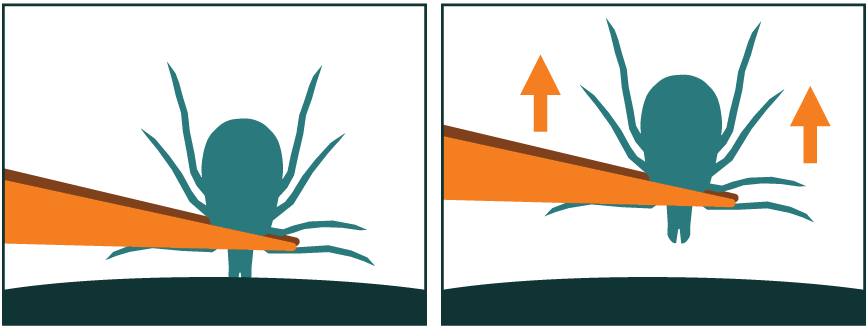Ticks are parasitic arachnids that are part of the mite superorder Parasitiformes. Adult ticks are approximately 3 to 5 mm in length depending on age, sex, species, and “fullness”. Ticks are external parasites, living by feeding on the blood of mammals, birds, and sometimes reptiles and amphibians
Types of ticks
Hard ticks and soft ticks have different life cycles, growing larger and changing their appearance at each stage.
Hard Ticks (Ixodidae)
Hard ticks (Ixodidae) begin as an egg that is laid by an adult female tick. Once the egg hatches a larva emerges that must then find and feed on a small mammal or bird (host). After feeding it drops to the ground from the host and goes through a molting process, emerging as a nymph.
Nymphal hard ticks then seek larger hosts, and after feeding drop off and molt into adults. The life cycle of hard ticks lasts one to two years depending on the species. The bite of a hard tick is generally painless, with a feeding process lasting several hours, to days, even weeks.
Soft Ticks (Argasidae)
Soft ticks (Argasidae), like hard ticks, begin as an egg, hatch into a larva, feed, and then molt into a nymph. Nymphal soft ticks may go through as many as seven phases as nymphs, requiring a blood meal at each stage.
Soft ticks’ life cycle lasts from months to years depending on the species. The bite is typically painless and only lasts 15-30 minutes, making it harder to detect.
While both hard and soft adult ticks are easiest to identify, it is important to note that nymphal ticks are equally capable of transmitting disease. In some areas the nymphal tick infection rate is actually higher than the adult tick infection rate.
As the Rainy season arrives, the cows are turned out to pasture, the tractors take to the fields, and the ticks become more active. As farmers, you are outside and should be wary of ticks as they can carry disease-causing bacteria and viruses. We worry about ticks on our pets and livestock, but sometimes we forget about ourselves. Farmers can be exposed to ticks due to the nature of their work.
PROTECT: Avoid areas where ticks live, use -registered tick repellents, and cover-up.
CHECK: Don’t let ticks hitchhike inside and check your whole body.
REMOVE: Remove attached ticks as soon as you can.
WATCH: Watch for symptoms and tell your provider if you get sick.
Protect
- Ticks live in wooded and brushy areas with high grass and leaf litter. Walk in the center of trails to avoid contact with host-seeking ticks.
- Take extra precautions in spring through fall when ticks are most active.
- Use an EPA-registered insect repellent on your skin.
- Consider treating clothing with permethrin, which kills ticks on contact and gives protection through several washes. Do not use permethrin on the skin.
- Talk to your veterinarian about tick prevention products for pets.
- Wear pants, long sleeves, and long socks. Light-colored clothing can help you spot ticks more easily.
Check
- Check clothing, gear, and pets before going inside.
- Put your clothes in the dryer on high heat for 10 minutes.
- Check your body and your child’s body: underarms, behind ears, around the waist, between legs, etc. Using a mirror can help.
- Take a shower to wash off unattached ticks and to help find attached ticks more easily.
Remove
Remove the tick as soon as you can. Use fine-tipped tweezers, or a tick removal tool, and follow the steps below. Don’t use petroleum jelly, a hot match, nail polish, or any other products to remove a tick. These methods don’t work!

- With a steady motion, pull straight up until all parts of the tick are removed. Don’t twist or jerk the tick. Don’t be alarmed if the tick’s mouthparts stay in the skin.
- Dispose of a live tick by putting it in alcohol, placing it in a sealed bag or container, wrapping it tightly in tape, or flushing it down the toilet. Never crush a tick with your fingers.
- Clean your hands and the bite area with rubbing alcohol or soap and water.
You don’t need to go to your health care provider or the emergency room to have a tick removed. If you have trouble removing the tick, or you can’t reach it, ask a family member or friend to help.
Acaricide failure has been on the rise in Uganda’s western and central cattle corridor. In the previous video, we identified the tick species. Today we will discuss how these ticks are associated with acaricide failure and determine their susceptibility to various acaricide molecules used for tick control in Uganda.
Ticks cause economic losses in the form of reduced blood, meat, and dairy products, as well as pathogen transmission. Different acaricides are currently used sequentially or simultaneously to control tick infestations on farms













